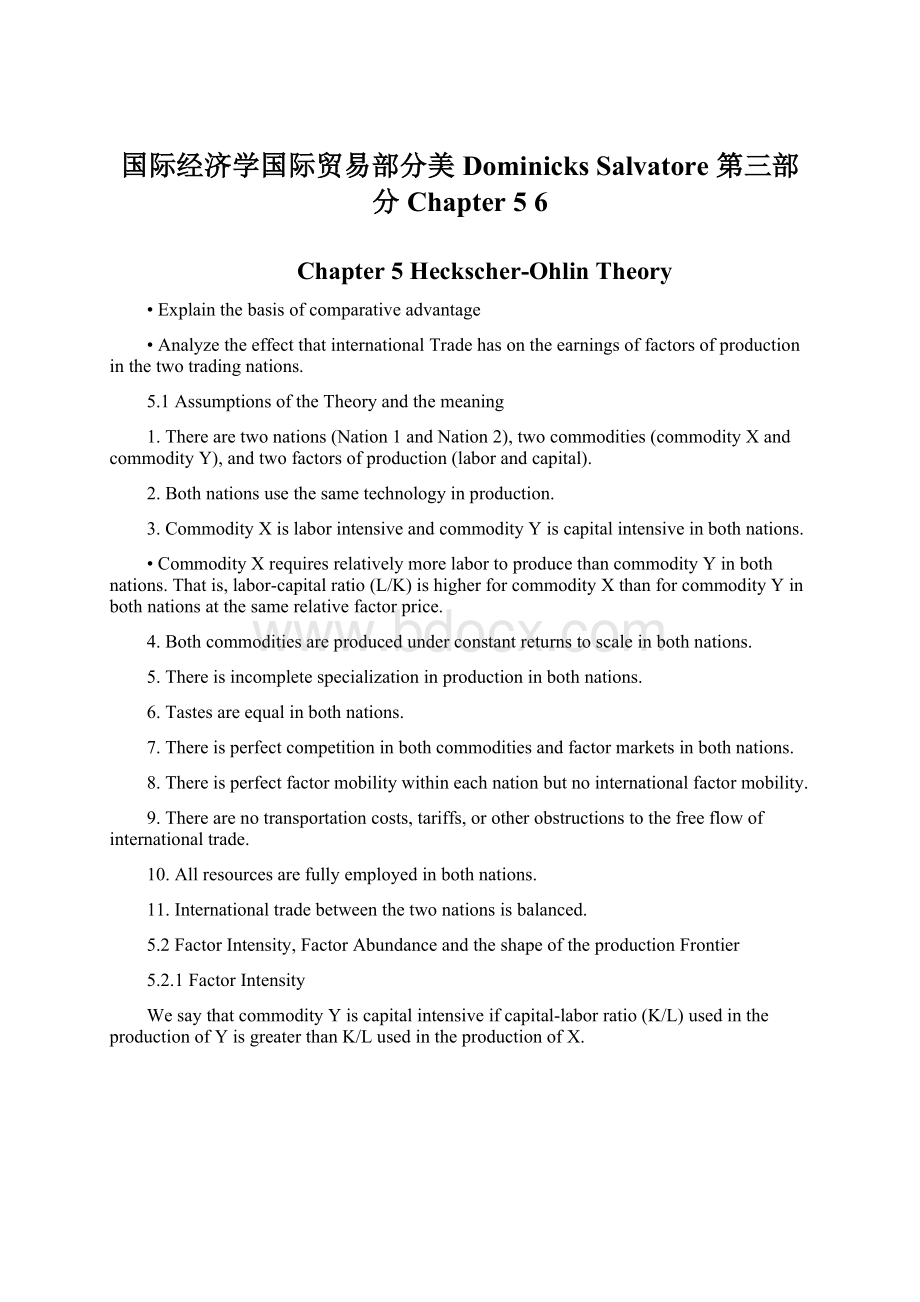 国际经济学国际贸易部分美Dominicks Salvatore 第三部分Chapter 5 6.docx
国际经济学国际贸易部分美Dominicks Salvatore 第三部分Chapter 5 6.docx
- 文档编号:3501891
- 上传时间:2022-11-23
- 格式:DOCX
- 页数:14
- 大小:338.80KB
国际经济学国际贸易部分美Dominicks Salvatore 第三部分Chapter 5 6.docx
《国际经济学国际贸易部分美Dominicks Salvatore 第三部分Chapter 5 6.docx》由会员分享,可在线阅读,更多相关《国际经济学国际贸易部分美Dominicks Salvatore 第三部分Chapter 5 6.docx(14页珍藏版)》请在冰豆网上搜索。

国际经济学国际贸易部分美DominicksSalvatore第三部分Chapter56
Chapter5Heckscher-OhlinTheory
•Explainthebasisofcomparativeadvantage
•AnalyzetheeffectthatinternationalTradehasontheearningsoffactorsofproductioninthetwotradingnations.
5.1AssumptionsoftheTheoryandthemeaning
1.Therearetwonations(Nation1andNation2),twocommodities(commodityXandcommodityY),andtwofactorsofproduction(laborandcapital).
2.Bothnationsusethesametechnologyinproduction.
3.CommodityXislaborintensiveandcommodityYiscapitalintensiveinbothnations.
•CommodityXrequiresrelativelymorelabortoproducethancommodityYinbothnations.Thatis,labor-capitalratio(L/K)ishigherforcommodityXthanforcommodityYinbothnationsatthesamerelativefactorprice.
4.Bothcommoditiesareproducedunderconstantreturnstoscaleinbothnations.
5.Thereisincompletespecializationinproductioninbothnations.
6.Tastesareequalinbothnations.
7.Thereisperfectcompetitioninbothcommoditiesandfactormarketsinbothnations.
8.Thereisperfectfactormobilitywithineachnationbutnointernationalfactormobility.
9.Therearenotransportationcosts,tariffs,orotherobstructionstothefreeflowofinternationaltrade.
10.Allresourcesarefullyemployedinbothnations.
11.Internationaltradebetweenthetwonationsisbalanced.
5.2FactorIntensity,FactorAbundanceandtheshapeoftheproductionFrontier
5.2.1FactorIntensity
WesaythatcommodityYiscapitalintensiveifcapital-laborratio(K/L)usedintheproductionofYisgreaterthanK/LusedintheproductionofX.
5.2.2FactorAbundance
Therearetwowaystodefinefactorabundance.Onewayisintermsofphysicalunits(i.e.,intermsoftheoverallamountofcapitalandlaboravailabletoeachnation).Anotherwaytodefinefactorabundanceisintermsofrelativefactorprices(i.e.,intermsoftherentalpriceofcapitalandthepriceoflabortimeineachnation).
1.Nation2iscapitalabundantiftheratioofthetotalamountofcapitaltothetotalamountoflabor(TK/TL)availableinnation2isgreaterthanthatinNation1(physicalunits).
2.Nation2iscapitalabundantiftheratioofrentalpriceofcapitaltothepriceoflabor(PK/PL)islowerinNation2thaninNation1(factorprice).
5.3TheHeckscaher-OhlinTheory
5.3.1Introduction
5.3.2TheHeckscher-OhlinTheorem
Anationwillexportthecommoditywhoseproductionrequirestheintensiveuseofthenation’srelativelyabundantandcheapfactorandimportthecommoditywhoseproductionrequirestheintensiveuseofthenation’srelativelyscarceandexpensivefactor.Inshort,therelativelylabor-richnationexportstherelativelylabor-intensivecommodityandimportstherelativelycapital-intensivecommodity.
5.3.3GeneralEquilibriumFrameworkoftheH-OTheory.
5.3.4IllustrationoftheH-OTheory
5.3.5AsimpletestificationoftheH-Otheory
例:
技术系数·要素价格·成本差距表
(1)技术系数
劳动(A)资本(B)
(2)要素价格
劳动(W)资本(R)
(3)成本
P=W·A+R·B
I国
0.750.25
0.250.75
40日元200日元
40日元200日元
PX=80日元
PY=160日元
II国
0.750.25
0.250.75
1美元1美元
1美元1美元
Px=1美元
Py=1美元
I国用大写母、II国用小写字母来表示。
X商品不加撇,Y商品则加撇。
在一般情况下,大写字母、不加撇就是在说明I国X商品。
现在假定商品成本P可以按下式计划:
P=W·A+R·B
(1)
这里A和B是每单位产品所需要的劳动量和资本量,W是劳动价格,即工资,R是资本价格,即利润率(=利息率)。
同时还要做如下假定:
1.每种商品的生产技术系数两国完全相同。
即:
A=a,B=b,A'=a',B'=b'
(2)
因此这种情况称为“同一技术系数”即:
,
2.但是同X商品相比,Y商品采取资本密集的技术系数即:
(3)
3.各国国内生产要素可以自由流动,通过市场的完全竞争,等质的生产要素在各产业部门都得到相同的报酬,不存在工资差异和利润率差异:
W=W',R=R',w=w',r=r'(4)
4.但是劳动和资本的相对价格Q=W/R两国相比,1国劳动较便宜,资本较贵,即:
Q=Q'<q=q'(5)
做了上述准备,根据假定的(3)式和(5)式,最后如能证明I国X商品、II国Y商品具有比较优势就可以了。
即证明PX/PY<px/py,换言之能证明PX/PY-px/py<0就可以了。
根据
(1)式:
再把
(2)式和(4)式考虑进去,就成为:
但是根据假定,Q<q,ρ<ρ',所以(Q-q)<0,(ρ'-ρ)>0,即:
(Q-q)(ρ1'-ρ1)<0(6)
因此,最后整个式子是负数。
从而证明了PX/PY-px/py<0,即PX/PY<px/py
5.4Factor-PriceEqualizationTheoremandIncomeDistribution
ItwasPaulSamuelson(1976NobelPrizeineconomics)whorigorouslyprovedthistheorem(corollary)(alsocalledH-O-Stheorem)
5.4.1TheFactor-priceEqualizationTheorem
•Wecanstatethefactor-priceequalization(H-O-S)theoremasfollows:
Internationaltradewillbringaboutequalizationintherelativeandabsolutereturnstohomogeneousfactorsacrossnations.Assuch,internationaltradeisasubstitutefortheinternationalmobilityoffactors.
•Forexample:
Laborinalltradingnationswillhavethesamereturn(wages);capitalreturnwillbethesametoo.
•Innational1,WeknowthatintheabsenceoftradetherelativepriceofcommodityXislowerinNation1thaninNation2becausetherelativepriceoflabor,orthewagerate,islowerinNation1.AsNation1specializesintheproductionofcommodityX(theL-intensivecommodity)andreducesitsproductionofcommodityY(theK-intensivecommodity),therelativedemandforlaborrises,causingwages(W)torise,whiletherelativedemandforcapitalfalls,causingtheinterestrate(r)tofall.
5.4.2RelativeandAbsoluteFactor-PriceEqualization
Ifalltheassumptionshold.Therewouldbeaonetoonerelationshipbetweenw/randPX/PY.
•Relativefactor-priceequalizationmeans
andalsow/r=(w/r)*
seeFigure5-5
•Absolutefactor-pricesequalization
①Equationofalsolutefactorpricesmeansthatfreeinternationaltradealsoequalizestherealwagesforthesametypeoflaborinthetwonationsandtherealrateofinterestforthesametypeofcapitalinthetwonations.
②proof
Euler'stheorem:
ifconstantreturnstoscaleprevailinproductionandifeachfactorisrewarded(paid)accordingtoitsproductivity,theoutputproducedisexhaustedandjustexhausted.Specifically,themarginalphysicalproductoflabor
(MPL)timestheamountoflaborusedinproduction(L)plusthemarginalphysicalproductofcapital(MPK)timestheamountofcapitalusedinproduction(K)exactlyequalstheoutputproduced.ThesameistrueforcommodityY.Inequationform,Euler'stheoremintheproductionofcommodityXcanbeexpressedas
(MPL)(L)+(MPK)(K)=X(5A-1)
DividingbothsidesbyLandrearranging:
X/L=MPL+(MPK)(K)/L(5A-2)
FactoringoutMPL:
X/L=MPL[(1+K/L)(MPK/MPL)](5A-3)
Withtrade,Nation1producesatpointBandNation2producesatpointB'.SinceatpointsBandB',w/risthesameinbothnations,MPK/MPLisalsothesameinbothnations.WealsoknowthatatpointsBandB',K/LintheproductionofcommodityXisthesameinbothnations.Finally,X/ListheaverageproductoflaborintheproductionofcommodityX—andthisisalsothesameinthetwonationsbecauseoftheassumptionsofconstantreturnstoscaleandthesametechnology.Asaresult,thelastremainingcomponent(MPL)inequation5A-3mustalsobethesameintheproductionofcommodityXinbothnationsifEquation5A-3istohold.
5.4.3EffectofTradeontheDistributionofIncome.
•TradeIncreasesthepriceofthenation'sabundantandcheapfactorandreducesthepriceofitsscarceandexpensivefactor.
•TherealincomeofLaborandofownersofCapitalmoveinthesomedirectionasthemovementinfactorprices.
•E.g.developednationscaseanddevelopingnationscaseandthepolicyimplication.
•empiricalRelevance
Sometimes,itismorerealistictosaythatinternationaltradehasreduced,ratherthancompletelyeliminated,theinternationaldifferenceinthereturnstohomogeneousfactors.
5.5theLeontiefParadox
•ThefirstempiricaltestoftheH-OmodelwasconductedbyWassilyLeontief.
•Forthistest,Leontiefutilizedtheinput-outputtableoftheU.S.economytocalculatetheamountoflaborandcapitalina"representativebundle"of$1millionworthofU.S.exportsimportsubstitutesfortheyear1947.
5.5.1Theresultsofthetestwerestartling,U.S.importsubstituteswereabout30percentmoreKintensivethanU.S.exports.——Leontiefparadox
5.5.2ExplanationsoftheLeontiefparadox
1.SkilledLaborTheory(Leontief)
•Sincein1947U.S.laborwasaboutthreetimesasproductiveasforeignlabor,theUnitedStateswasreallyanL-abundantnationtoU.S.importsubstitutes.
2.HumanCapitalTheory(P.B.Kenen)
•Humancapitalreferstotheeducation,jobtraining,andhealthembodiedinworkers,whichincreasetheirproductivity.TheimplicationisthatsinceU.S.laborembodiesmorehumancapitalthanforeignlabor,addingthehumancapitalcomponenttophysicalcapitalwouldmakeU.S.exportsmoreKintensiverelativetoU.S.importsubstitutes.
3.TheoryofTechnologicalGap(M.U.Posner,W.Gruber,R.Vernon)
•TechnologyistheresulttoinvestinR&D,andisalsoonekindofproductionfactor.Ofcoursethereexistcomparativetechnologyadvantagesforthetechnologygapamongnations.
5.6Factor-IntensityReversal
5.6.1Factor-intensityreversalreferstothesituationwhereagivencommodityistheL-intensivecommodityintheL-abundantnationandtheK-intensivecommodityintheK-abundantnation.Forexample,factor-intensityreversalispresentifcommodityXistheL-intensivecommodityinNation1(thelow-wagenation)and,atthesametime,itistheK-intensivecommodityinNation2(thehigh-wagenation).
•whenfactor-intensityreversalispresentneithertheH-Otheoremnorthefactor-priceequalizationtheoremholds.
5.6.2IllustrationofFactor-IntensityReversal
Chapter6NewInternationalTradeTheory
6.1H-OModelandNewTradeTheories
RelaxingassumptionsofH-OmodelandNTT.
1.Therearetwonations(Nation1andNation2),twocommodities(commodityXandcommodityY),andtwofactorsofproduction(laborandcapital).
2.Bothnationsusethesametechnologyinproduction.——Technologygapandproductcyclemodel
3.CommodityXislaborintensiveandcommodityYiscapitalintensiveinbothnations.——nofactor-int
- 配套讲稿:
如PPT文件的首页显示word图标,表示该PPT已包含配套word讲稿。双击word图标可打开word文档。
- 特殊限制:
部分文档作品中含有的国旗、国徽等图片,仅作为作品整体效果示例展示,禁止商用。设计者仅对作品中独创性部分享有著作权。
- 关 键 词:
- 国际经济学国际贸易部分美Dominicks Salvatore 第三部分Chapter 国际 经济学 国际贸易 部分 Dominicks 第三 Chapter
 冰豆网所有资源均是用户自行上传分享,仅供网友学习交流,未经上传用户书面授权,请勿作他用。
冰豆网所有资源均是用户自行上传分享,仅供网友学习交流,未经上传用户书面授权,请勿作他用。
链接地址:https://www.bdocx.com/doc/3501891.html


 转基因粮食的危害资料摘编Word下载.docx
转基因粮食的危害资料摘编Word下载.docx
 工业催化剂的失活与再生PPT资料.pptx
工业催化剂的失活与再生PPT资料.pptx
